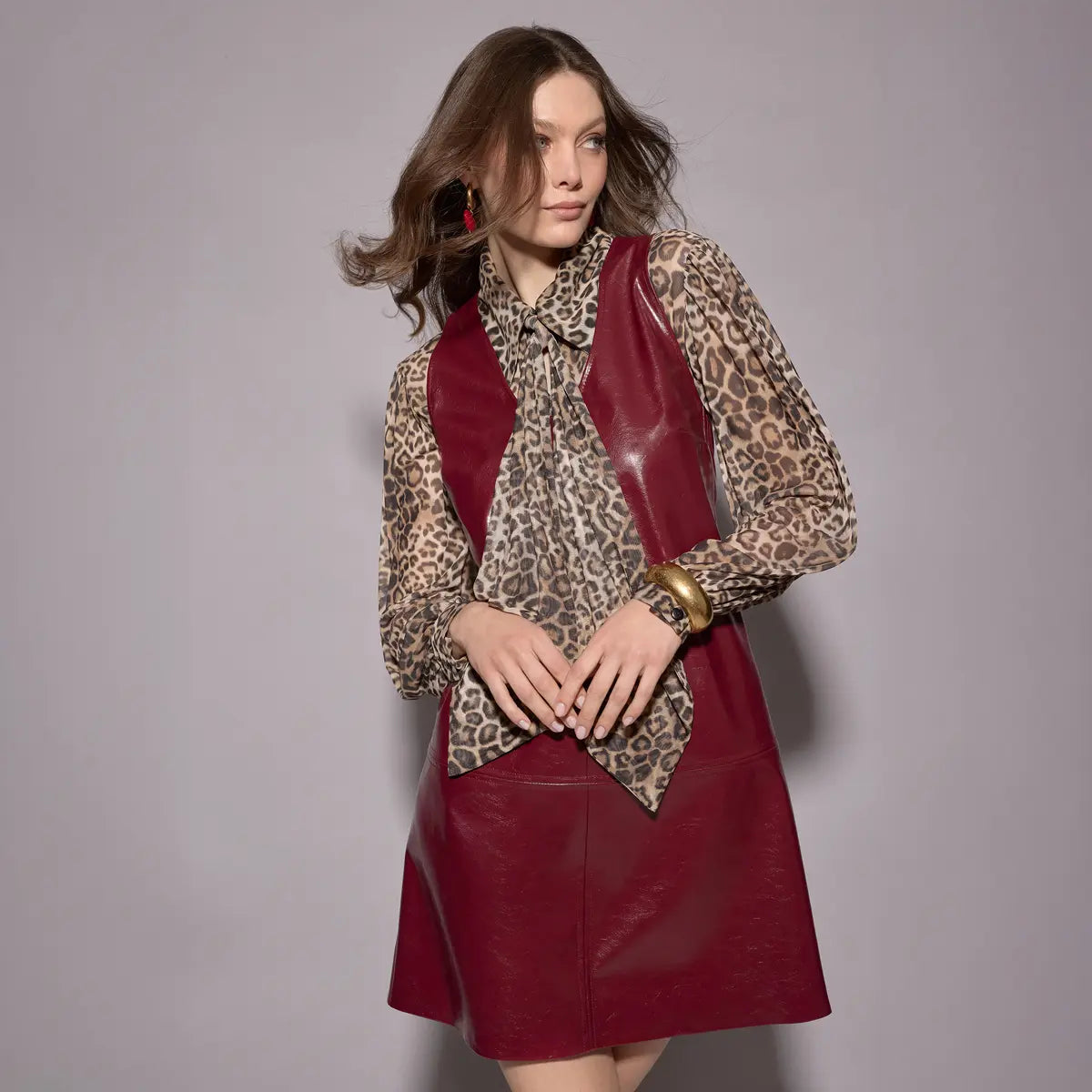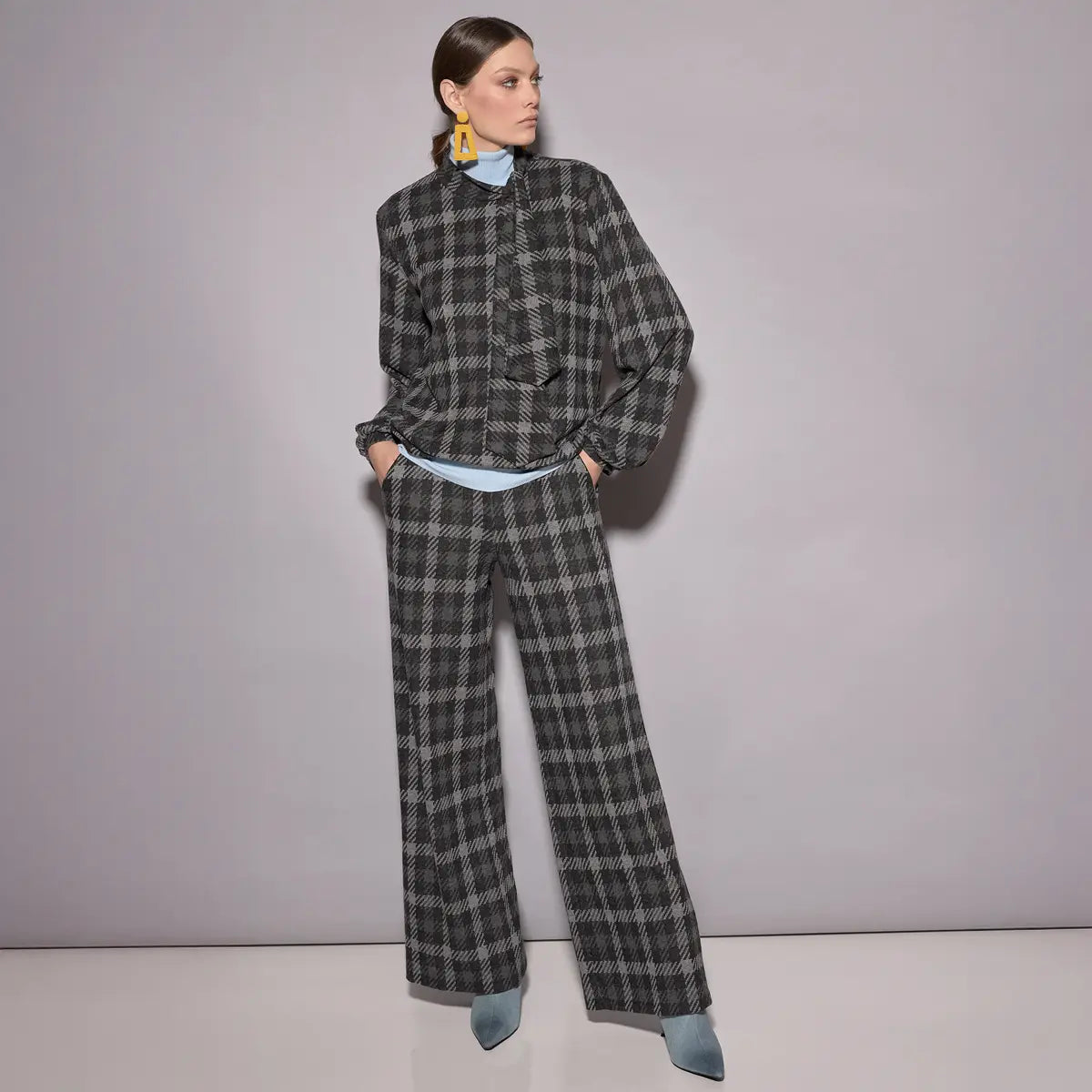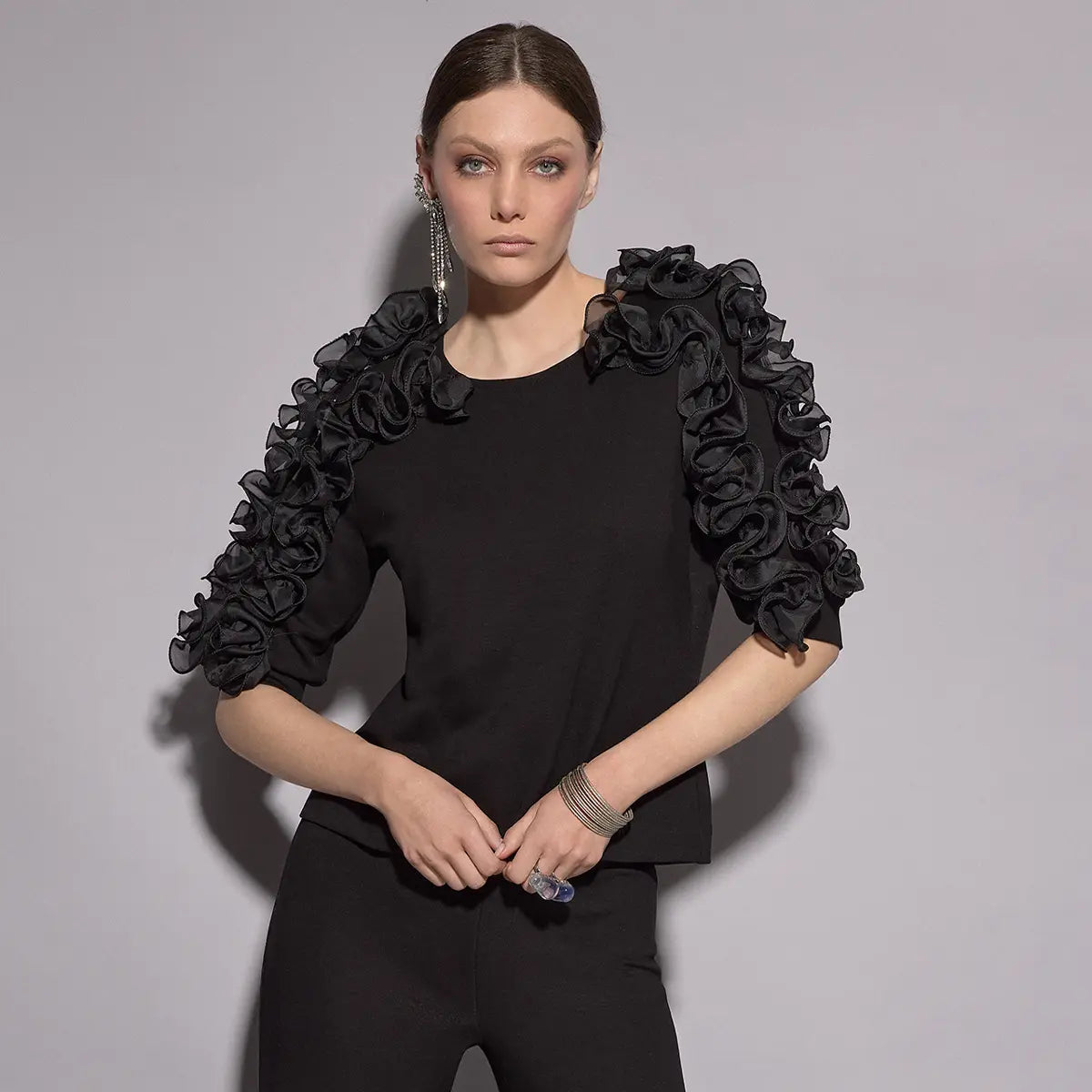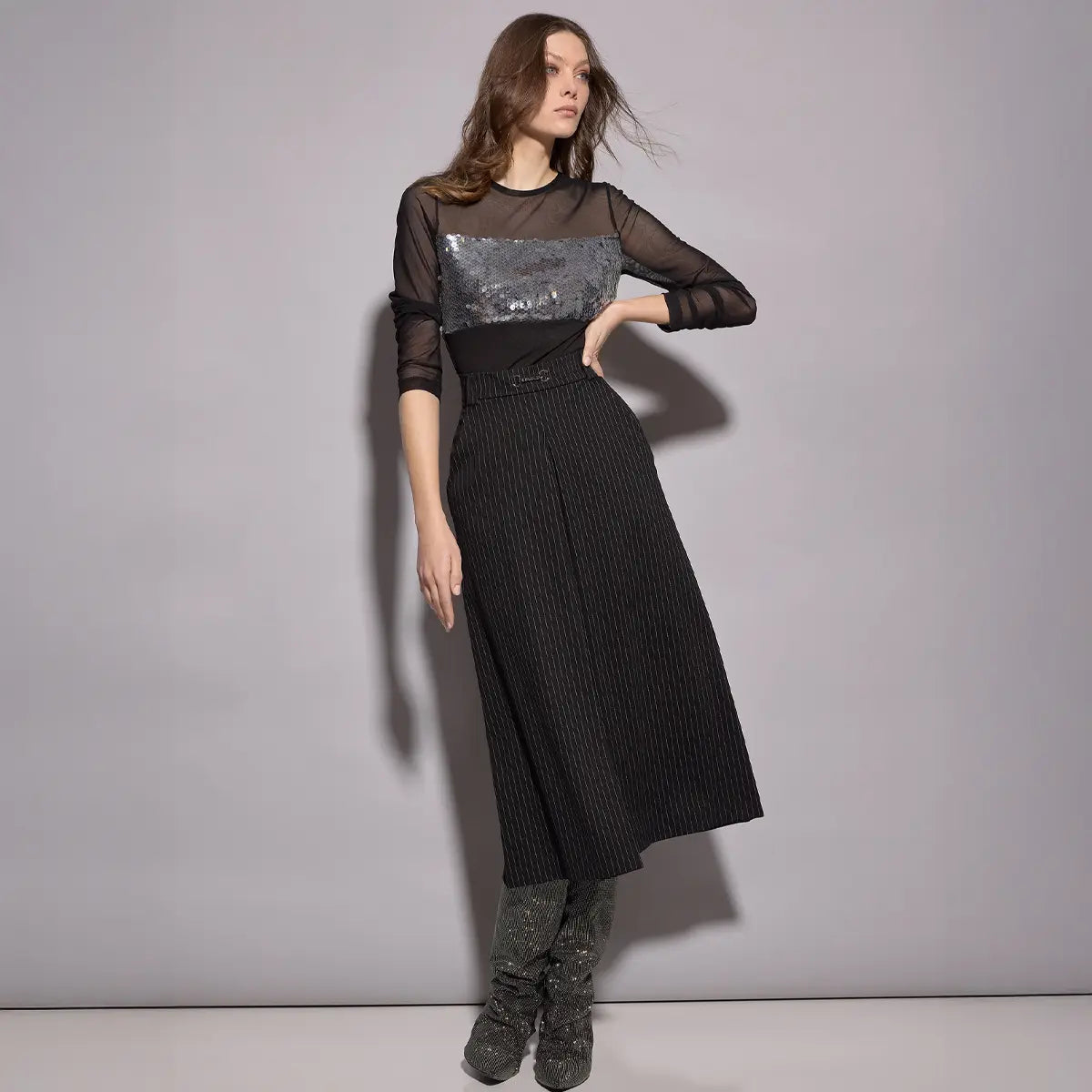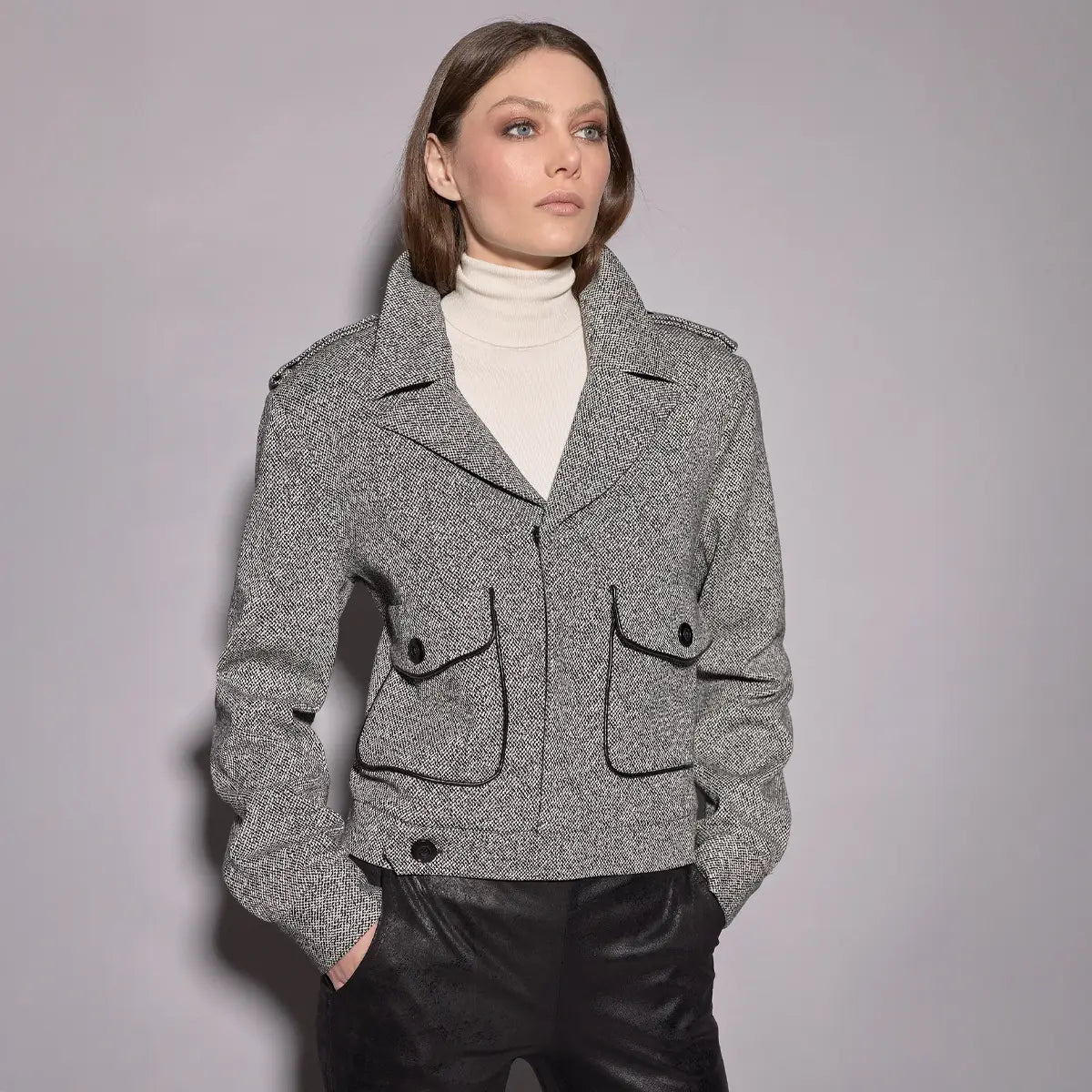Your Complete Guide to Jacket & Coat Types
Browse our A–Z overview of jacket and coat styles and discover which cut suits your style, your silhouette and your wardrobe.

Anorak
‘Something against the wind’ – this is how the meaning of ‘anorak’ can be translated from the language of the Greenlandic Inuit. The original model was consistently sewn from sealskin. Today, the variety of anorak styles is almost endless: sporty, cool or elegant, with a zip or pull-over, oversized or as a tailored short model, with a sophisticated hood with or without faux fur trim. It always depends on whether the anorak is intended to fulfil a specific function, for example in alpine sports, running or cycling. In most cases, breathable materials are used, while heat-retaining filling materials such as down or synthetic Hollofil fibres are used for extreme temperatures.
The lightweight version? The windbreaker that mountain hikers always carry with them – usually in a pleasantly minimal pack size in their rucksack. When it comes to colour design, anything is possible – from monochrome to watercolour prints. Anyone who thinks that anoraks can only be combined with sportswear or casual looks is mistaken. All figure-hugging dresses in mini or midi lengths are a trendy match, as are dresses with hoods, made of jersey or denim materials.
Style guideline:
Go for a deliberate style break and combine tight dresses with an anorak.
Suitable shoes:
Sneakers, Chelsea boots, sturdy lace-up boots, moon boots

Blazer
It always looks good and is much more versatile than commonly assumed: the blazer. It has long been a unisex classic. In its early days, it was designed as a double-breasted jacket that reached down to the thighs and was made of black or navy blue flannel. The blazer found early fans in the British boating and cricket culture of the late 19th century. The blazer experienced its greatest revival in the 1950s, when British schoolboys wanted to spice up the blazers in their school uniforms. In 1975, Giorgio Armani presented his first men's blazer collection. In the late 2000s, women discovered colourful single-breasted blazers for themselves.
Today, the jacket is available in countless variations, colours and shapes, with and without shoulder pads. The classic pinstriped business blazer is a great way to convey professionalism. There are styles to suit every leisure activity: a checked blazer with a knitted dress and baseball cap is just as hip as a boyfriend blazer with a floral print, flowing maxi dress.
Style guideline:
Blazers are not only popular for business, but also as transitional jackets.
Suitable shoes:
Sneakers, pumps, stilettos, mules, flat lace-ups

Bomber Jacket
Strictly speaking, the cool bomber jacket – just like the college, baseball or racer jacket – is a blouson. This refers to a jacket that is at least waist-length and has a wider cut, characterised by tight, elasticated cuffs at the waist and sleeves. Come fly with me! – The bomber jacket we love today was influenced by First World War pilots and the Air Force. It has a low stand-up collar, a full-length zip and a padded lining. Originally, pilot jackets were green, which is why this well-known fashion item is often seen in colours such as khaki. It is suitable as a transitional jacket – depending on the material, which can be water-repellent, waxed or even leather.
Punks in particular discovered this masculine jacket for themselves. From red to metallic to knee-length models with embroidery or patches – regardless of the variant, the bomber jacket retains its sporty touch. Outfits look cool above all else. The bomber jacket is easy to combine – with casual boots or, for a more feminine look, with a tight skirt and kitten heels.
Style guideline:
Glam style with leather or glitter mini makes the bomber jacket spectacular.
Matching shoes:
Over-the-knee boots, high heels, rubber boots with thick soles, trainers

Bolero
They are a standard feature in Andalusian arenas – the short jackets that are part of the Spanish torero's traditional costume. Elaborately embroidered, these waist-length jackets are open at the front, have long sleeves and are usually made without buttons. They often only reach to just below the bust. It was only later that designers discovered them for their collections. Incidentally, bolero jackets are also known as ‘cache coeur’ because they warm the hearts of those who wear them.
In the 1950s, women complemented light summer dresses or swinging petticoat styles with boleros made of fine yarns. Boleros are available with long and short sleeves. Most of the jackets are so tight-fitting that they can simply be pulled on; sometimes they have hooks, tiny buttons, a short zip or a tie to close them. Today, there are no limits to the shape and colour of boleros. Longer, shorter, with prints or appliqués; made of cotton, wool, denim, silk or chiffon – anything goes. Elegant styles are worn with cocktail dresses, while light wrap boleros are the perfect match for summer dresses in flower power designs or with polka dots.
Style guideline:
Adds an individual touch to any look and can change the style of an outfit in an instant.
Suitable shoes:
Ballerina flats, sandals, wedges, trainers, high heels

Pea Coat
From the high seas to the catwalks – this fashion classic has a military past: first worn by Breton fishermen, the caban jacket or Pea Coat quickly made an international career in the navy. In the US Navy, it is known as a pea coat. This jacket is usually made in a uniform style from sturdy wool fabric in blue, black or dark green. The double-breasted button placket – usually with gold metal buttons, but also with brown wooden or plastic buttons – is another distinguishing feature of this sporty-chic, timeless classic for men and women. Models made of herringbone fabric and worn with the collar turned up exude unmistakable British flair. The autumnal transitional model usually reaches just above the hips or to the thighs and has a figure-hugging cut. Other typical features include the wide lapel collar and side pockets. As a true classic, this short jacket also goes well with elegant midi or maxi dresses – as long as they don't lean towards bohemian style.
Style guideline:
Goes with almost everything – casual outfits, business looks or very feminine ensembles with elegant dresses or tulle skirts; make sure the hem length is appropriate for dresses.
Suitable shoes:
Elegant, slim-fit boots, designer wellies à la Burberry or Bottega Veneta, flat lace-ups, pumps

Cape
The perfect mix of coat and blanket – joking aside, in addition to its cosy enveloping factor, the cape also has a high styling level. A cape is a wide, flowing, sleeveless cloak, which often also has a hood. Characteristic features are the A-line cut and slits instead of sleeves. The designs are made of heavy wool fabric or thinner materials and can be fastened with zips, buckles or buttons.
Capes are particularly popular in the transitional seasons – this is also reflected in the most common colours: from soft cream and rose tones to shades of green and grey to dark colours such as brown or black. On warmer days, a cape worn over a knitted jumper or long tube dress is perfect for going out, while in cooler temperatures it can be worn like a protective cloak over a thin quilted jacket. Either way, it always adds a special charm. This also applies to the functional version as a rain cape.
Style guideline:
Layering styles get the finishing touch with a cape.
Matching shoes:
Depending on the outfit – the whole spectrum from glittery high heels to boots.

Down Jacket
When temperatures drop, it's boom time for the down jacket. Few garments envelop us so fashionably and protect us from snow, wind and cold. The fluffy model survives every short-lived trend season after season. No wonder: the long, padded coats with Michelin man vibes are feather-light and quilted to provide optimal thermal insulation. The quilted chambers ensure that the down remains evenly distributed. Water-repellent polyamide optimises comfort. Hoods with sweeping faux fur trim add a fashionable touch. Particularly colourful styles in red, turquoise or pink make winter even more stylish à la dopamine dressing. Did you know? Flared dresses and skirts paired with chunky boots and a down coat make for a harmonious fashion match.
Style guideline:
Combine different silhouettes to counteract the volume effect.
Matching shoes:
UGG boots, knee-high leather boots, heeled ankle boots, Nike Dunks

Duffle Coat
One of the style icons among British coats: The duffle coat is characterised by its distinctive wooden or horn toggle fastenings, hood and patch pockets. The garment owes its name to the Belgian town of Duffel, south of Antwerp, where the specific cotton fabric, known for its particular weight, originates. The original navy duffle coats were more voluminous than modern versions. The toggle fastening consists of a loop that forms the fastening in combination with a button. The short coat was designed from water-repellent wool fabric to protect Royal Navy soldiers from wind and weather. The fit has since been modified, but the silhouette is still boxy. Incidentally, the duffle coat is the only classic coat that features a hood. Thanks to its simple lines, the coat can be worn with jeans and a sweater for a sporty, relaxed leisure look, or with a pencil skirt, blouse and slipover for an office outfit.
Style guideline:
Duffle coats go particularly well with trouser suits – after all, they were designed to be worn with military uniforms.
Suitable shoes:
Ankle boots, booties, trainers

Duster Coat
For many, it is the perfect summer coat: the duster. Straight cut, very long and made of light materials such as linen, satin or silk, it stylishly complements our outfits. Most models have a high slit at the back. A triangular piece of fabric with the tip pointing upwards is incorporated into the slit, providing the necessary legroom when sitting. This was originally intended to protect against dirt when riding or on the coach box, hence its nickname ‘dust coat’. The coat has a very wide button placket at the front and a collar that can be turned up.
The history of the super-lightweight long coat began in 18th-century North America and Australia. This functional workwear later became popular among all social classes as summer rainwear. Light and subtle colours are still typical today. Combine it with a jumpsuit or maxi dress for a successful street style look.
Style guideline:
For an extra dose of femininity, wear the straight-cut duster with a fabric belt; roll up the sleeves for even more casualness.
Matching shoes:
Sneakers, mules, peep-toe sandals, kitten heels, suede ankle boots

Short Coat
It's a must-have in your wardrobe – the one good coat for all occasions. The short coat is between a jacket and a coat in length and, depending on the style, can exude 60s flair. It's practical simply because it's suitable for both cool, rainy summer days and cold autumn and winter days. This coat style is also an all-rounder thanks to its straight, simple cut with a lapel collar and button placket. Depending on the shape of the pockets or collar, the short coat can also exude a more playful look. The ideal companion for dresses or skirts, it turns any outfit into a skilful, feminine and elegant style.
Style guideline:
Particularly suitable for petite women who can easily disappear under voluminous coats.
Suitable shoes:
Boots, trainers, lace-ups, shoes with medium heels

Denim Jacket
Denim all over! The denim jacket is both a fashionable accessory and a transitional jacket. Usually cut to waist length, the denim fabric protects against light breezes and keeps us warm in the summer evenings. The denim jacket has been experiencing a revival for several years now and is ubiquitous in summer. The robust material does not crease, which also makes it the ideal companion for summer parties that last into the morning.
The inventor? Levi Strauss. In 1873, he designed denim work trousers in America, followed seven years later by the first denim jacket. At the time, it was called the ‘Triple Pleat Blouse’. The men's jacket had a boxy cut and did not yet have the typical breast pockets. Today, denim jackets are also available in different cuts, such as the oversized boyfriend style. Pair them with tight knit dresses and Chucks for a cool outfit. But this all-time favourite also turns all romantic midi and maxi dresses into fashion highlights.
Style guideline:
Anything goes – denim with denim, denim with prints, denim with silk, denim with knitwear.
Matching shoes:
Chucks, chunky boots, trainers, booties, ballerinas, Mary Janes

Leather Biker Jacket
It is undoubtedly an icon – the leather jacket. No other jacket is so intensely associated with the image of adventure, coolness and freedom. In the 1960s, the black leather jacket achieved cult status and replaced the bomber jacket in Hollywood hero epics. In the years that followed, Hollywood idols set the trend in terms of the cut and colour of leather jackets. Today, there are models in a wide variety of leather types and colours – smooth leather, suede or with fringes. Biker jackets in particular are often made of sturdier leather and feature a diagonal zip. There are models with collars or round necks. Wider-cut styles are equipped with a warm inner lining. Leather jackets are now available in all colours, with natural colours and black predominating. Whenever we want to give our outfit a cool touch or go for a style break, a leather jacket is the perfect choice: the sequinned party dress loves the leather jacket just as much as a wide, flowing summer dress in mini or maxi length.
Style guideline:
Buckles and front-tie belts make leather jackets even cooler; wear them closed with a wide midi skirt.
Matching shoes:
Wedges, sandals, stilettos, cowboy boots, naked heels, ballerinas

Long Coat
It comes in bright colours, as a double-breasted coat, with a checked pattern or in classic anthracite or camel – the key thing with a long coat is that it should reach at least to the shin, but usually to the ankle. The classic straight-cut wool coat with a belt looks elegant with dresses on cold days. Paired with chunky heels and a maxi floral dress, it creates a feminine outfit that subtly references the 70s. For a tone-on-tone outfit, combine a cream-coloured coat with boots in the same colour, for example. The long wool coat is a timeless classic that comes back into fashion every season.
Style guideline:
When positioned correctly, the waist belt of a long coat sits above the hip bone and flatters the natural shape of the body.
Suitable shoes:
Boots, elegant slim-fit boots, Chelsea boots, ankle boots

Parka
The parka is an all-rounder – regardless of whether it is loose-fitting or tailored with a drawstring, buttons or a zip. A parka is a mid-length anorak with a detachable hood and large pockets. It has a warm lining and the hood is encircled by a faux fur collar.
Like the anorak, the parka was invented by the Inuit, an ethnic group living in north-eastern Canada and Greenland. ‘Parka’ means ‘heat’. This refers to the fact that this jacket keeps you warm even in extreme weather conditions. The military and, in the 1960s, British mods loved this practical garment. Still often available in olive green and dark blue, today's casual parka comes with sophisticated details such as double fastenings, different pocket styles and variable collars – and, of course, in designs ranging from camouflage to glitter.
Style guideline:
Stylish style break – combine a parka with a feminine slip dress and biker boots.
Suitable shoes:
Biker boots, ankle boots, chunky trainers

Puffer Jacket
Insulating jacket or style statement? The puffer jacket doesn't have to choose. It originates from outdoor fashion and is a voluminous quilted jacket with down filling or other heat-insulating inlays. At the same time, it is breathable and lightweight – and therefore comfortable to wear. That's why, in addition to mountaineers, subcultures of the 90s such as rappers and skaters soon became interested in the warm and uncomplicated designs.
The puffer jacket can be seen every winter, even if the cuts vary greatly from season to season. Shorter puffer jackets are setting the trend, but the jacket is also available in an XXL version and in countless colours and patterns. It usually features a minimalist, cool design. Whether nude, pastel or bright colours – anything goes. The same applies to styling – puffer jackets and dresses also go well together.
Style guideline:
Down jacket, but chic – and therefore long since arrived on the catwalks.
Matching shoes:
Sneakers, boots, flat boots

Quilted Jacket
The name says it all: the quilted jacket is a functional jacket made of quilted material. Depending on the cut and material, the padded jacket can look both sporty and feminine. The inventor is the American pilot Steve Gulyas, who developed the jacket in the 1950s as special clothing for the Air Force. Later, quilted outerwear became a favourite of the British royals. The model with the velvet collar, worn by Queen Elizabeth on horseback rides, became a trademark of English style.
Padded jackets have long since shed their conservative image, and fashionistas have discovered the style for autumn and early winter looks. Pair it with a midi skirt, leggings and high boots to create a cool autumn look. Jeans and business trousers also show off the jacket to its best advantage. Don't forget accessories such as a scarf and bag.
Style guideline:
The more voluminous the padding, the slimmer the garments should be at the hips and legs.
Suitable shoes:
Knee-high boots, boots, lace-ups, Dr. Martens with platform soles.

Trench Coat
This classic coat is our declared favourite – its typical cut has been delighting fashion fans for 100 years! Thomas Burberry laid the foundation for this in 1897 when he developed gabardine. The fabric is made of cotton and woven from a compact twill yarn. The water-repellent and sturdy fabric was initially used for military purposes; from 1914 onwards, the trench coat was part of the British Army's equipment.
When Audrey Hepburn walked across the screen in a trench coat in Breakfast at Tiffany's, it wasn't long before the doors to the catwalks opened. Characteristic features include the double button placket, the collar on the shoulders, the waist belt, the epaulettes and sleeve clasps, and the wide lapels. Even today, the trench coat is still considered the ultimate all-weather coat. Trench coats go well with elegant dresses, shift dresses and classic business looks, but can also be worn with jeans for everyday wear.
Style guideline:
Exciting! The so-called shoulder pads – the second layer of fabric on the shoulders – serve to allow rainwater to run off.
Suitable shoes:
Pumps, trainers, all elegant boot styles.

Gilet / Vest
Perfect for layered looks, the gilet (or vest) is essentially an outerwear piece without sleeves. Originating in classic menswear, it first appeared in the 17th century as a fitted under-jacket worn beneath a justaucorps, evolving from the traditional doublet of that era. To this day, the waistcoat remains part of the classic three-piece suit in men’s tailoring. The traditional gilet – now also a fashion favourite for women – is cut to the waist, fastens at the front with buttons and is worn over a blouse, shirt or fine knit. But today’s gilets offer far more than the classic interpretation: fashion-forward versions include quilted gilets, wool vests, long knit styles, teddy gilets and modern designs ranging from cropped to knee-length, and from sleeveless to cap-sleeve variations. Colourful gilets create a playful, unconventional look and are perfect for stylish contrasts. Pinstripe styles, on the other hand, bring a timeless, tailored elegance — ideal as a chic alternative to a blazer for business occasions. Thanks to their sleeveless design, gilets offer endless outfit possibilities and modern silhouettes — they’re especially striking layered over long printed dresses.
Style Guideline:
There is only one rule for styling a gilet: never layer another piece over it — the sleeveless effect gets lost otherwise.
Matching Shoes:
Completely flexible — any style works depending on your outfit: from loafers and sneakers to boots or heels.
Jackets & coats with impact – perfectly balanced silhouette, material & length
A successful outerwear look is created when the silhouette, material and length are in harmony: volume (e.g. puffer, down) looks precise with slim bottoms, flowing shapes (cape, duster) thrive on layering and clean lines, classic tailoring pieces (blazer, trench, caban) benefit from contrasting textures. Use belts, collars and shoes as styling levers – this keeps your outfit and coat in balance and bears the signature of Ana Alcazar.







